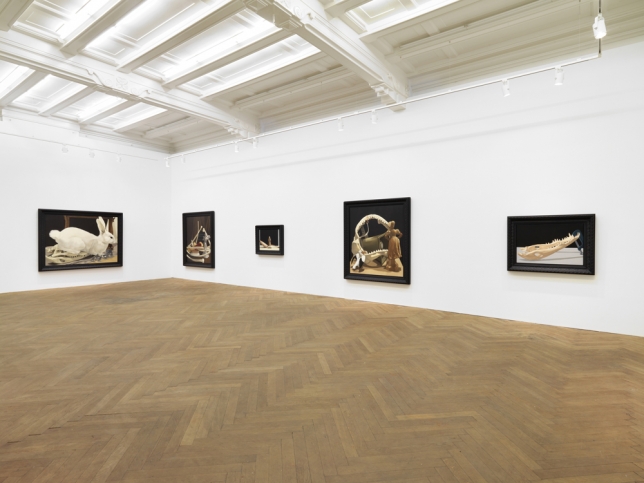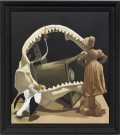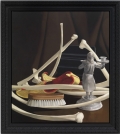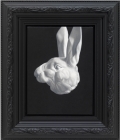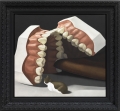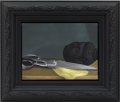Natee Utarit
Illustration of the Crisis
Opening: 11 September 2012 - 6 -9 p.m.
12 September to 17 October 2012
ARNDT Berlin is proud to present Illustration of the Crisis, the first solo exhibition of Thai artist Natee Utarit in the city of Berlin.
Looking at the past to understand the present.
On Natee Utarit's Illustration of the Crisis.
By Katerina Valdivia Bruch
Initially influenced by German Expressionism and abstract art in his early body of work, Utarit has undergone an exploration on the medium of painting connecting it with photography and classical Western art. Light and perspective are some of the elements the artist choses to work with, focusing on painting as a means to explore image making. In the last decade, his paintings have been inspired by old masters of Western art history from the Italian Renaissance - such as Fra Angelico (1395-1455) or Paolo Uccello (1397-1475) - and the Baroque era, approaching in a critical way Thai social subject matters.
Between 2009 and 2011, Thailand was living a series of political contradictions that were affecting public life in the country. It was more a crisis connected to power relations and Buddhist belief rather than just an economical crisis related to the country's development. For the artist, Thai's current crisis is intangible and therefore complex to understand as it is happening in Thai's soul: "It is a crisis that strikes at the heart of some of our most treasured illusions, those which have sustained us for centuries and that only we Thais can understand in the context of our own society and our own cultural beliefs."
But, how can we illustrate this crisis on canvas? Thus, the complexity of the picture language allows him to speak about these sensitive issues. The artist considers that the symbolism of the 15 - 17th centuries Western painting techniques, such as landscape and still life, are capable to show multiple layers of reality. For him, "This language relied heavily on metaphors and hidden symbols to communicate" . In the series Illustration of the Crisis, the artist uses "the language and grammar of painting of the past" to portray current social concerns.
The change in power has made people afraid of an unpredictable future. There has been a construction of an image of happiness founded on the basis of fear and anxiety. In order to express these contradictions, the artist includes symbols of Thai society and politics in a dreamlike atmosphere. Although this possible world is based on his personal imagination, for him "There is no irony. There are no optical illusions. Everything is meant to tell a story in the same direct manner that characterised paintings for centuries." In general, the artist refers to his work as dealing with social issues rather than considering it political art, confronting local subjects with universal human themes.
Before starting to work, Utarit composes an artificial scenery created with objects chosen from antique markets or accumulation shops (similar to flea markets). During his search, he tries to find items that are suitable to be painted, in order to later create a dialogue between the found objects and the ideas he wants to transmit with them.
The artist's studio reminds us of a sort of medical laboratory or a room for experiments, in which all objects are closely observed, organised and separated. Later, he will put some objects together in a particular arrangement meaningful for him. After this process of composition, he photographs the dialogic setup of the items. While painting, he chooses the proper colours to create the atmosphere he wants to achieve. This artificiality creates some distance between the hidden reality he is addressing and leaves the viewer the option to decipher the questions he is posing to the audience. To reach a more abstract environment, the artist deliberately does not take nature as an example to create the settings of his canvases. And, right after setting up this artificial scenario, he starts to paint.
In the series Illustration of the Crisis, the symbolic language and the dialogue of the objects portrayed by the artist mix elements of reality and fiction, combining found objects such as bones, brushes, scissors, spoons, old chandeliers, a head of a Buddha or busts of military characters with plastic toys, anatomy models and plastic animal figures. In fact, these animals are not intended to correspond to real animals. More likely, they are metaphors of different human behaviours, thoughts and emotions, as if we would be speaking of characters taken from fairytales.
Symptoms of the crisis are visible in the use of animal jaws, such as in Inward Looking (2012), in which the mouth of a shark skeleton, containing an old megaphone, seems to be shouting at the figure of an European woman wearing 19th century clothes, or in The Bridge (2012), where a rabbit lies on an animal jaw behind some toy soldiers facing the front, but also in Crocodile Tears (2011), in which the title itself stands for hypocrisy. It seems as if you open your mouth you might get into trouble, as in Saying the truth is a suicide (2012) with a false human teeth. According to the artist, his works "are telling things that are beyond speaking and most people in our society are not willing to hear or talk to".
Utarit's canvases are famous for questioning the nature of images and how these are made: either influenced by photography, or combined with elements from landscape painting or still lifes, or taking ideas from antique markets, the language of painting in Illustration of the Crisis is challenging the audience to reflect on the multifarious possibilities to understand contemporary painting, but also to take a look at ways to address contemporary issues.
The current series, on view at the gallery, is a continuation of his previous explorations on the pictorial language of Western painting techniques. Earlier series, such as Pictorial Statement (2000), connected reproductions of old masters with Thai landscapes, or The Last Description of the Old Romantic (2005) used copies of floral still lifes. For him, the multiple facets of reality are best depicted through these means.
Natee Utarit was born in 1970 in Bangkok, where he lives. He studied at the College of Fine Art, and graduated in Graphic Arts at the Painting and Sculpture Faculty at Silpakorn University, both in Bangkok. During his art studies at Silpakorn University, he was influenced by classical art, but also by theories of postmodernism that deconstruct classicism connecting it to modern concerns.
His international career dates back to the late 1980's, participating in group exhibitions such as the Third Asia-Pacific Triennial of Contemporary Art Brisbane (1999), Next Move: Contemporary Art from Thailand at La Salle College of the Arts (2003) or Traces of Siamese Smile: Art, Faith, Politics and Love at the Bangkok Art and Culture Center (2008). Recent solo exhibitions include The Amusement of Dreams, Hope and Perfection at the Art Center of Chulalongkorn University (2007) and Natee Utarit: After Painting at the Singapore Art Museum (2010). His work is part of renowned collections, such the Bangkok University, the Queensland Art Gallery, the Singapore Art Museum, as well as private collections in Europe and Asia.
Please click here to view the list of exhibited works.
For any further questions, please contact Lisa Polten (lisa@arndtberlin.com).
